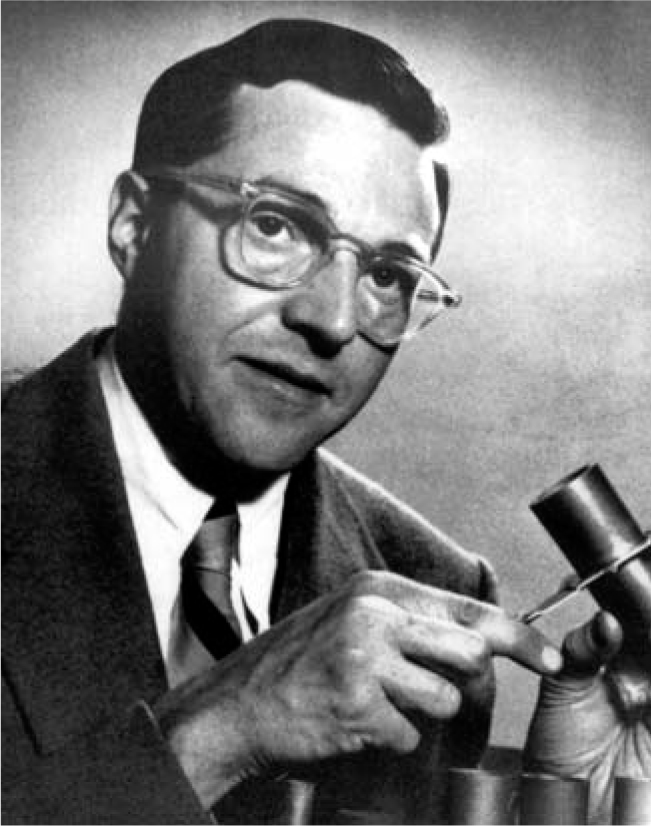Leo Brewer
DOI: 10.1063/1.2195326
Leo Brewer, the founder of modern high-temperature chemistry, died 22 February 2005 in Berkeley, California, after several years of declining health. His career, like that of many scientists of his generation, was forged by his participation in the Manhattan Project.
Leo was born 13 June 1919 in St. Louis, Missouri. His family ultimately moved to southern California, and, since he was a bright student, it was natural for him to attend Caltech in Pasadena. He received his BS in 1940, and Linus Pauling there advised him to go to the University of California, Berkeley, for his PhD. At that time Leo was an organic chemist; his thesis work at Berkeley, with Axel Olsen, was on the chemical kinetics of the iodination of mesityl oxide. But by that time most chemists at Berkeley were becoming engaged in the Manhattan Project, so Leo finished his thesis work in 28 months to join the project. Once with the project, he was first told of the new secret element, plutonium. Wendell Latimer and Ermon Eastman then assigned him the task of learning how to handle large amounts of the metal at high temperatures.
Working with Leroy Bromley, Paul Gilles (who later became Leo’s first graduate student), and Norman Lofgren, Leo investigated various refractory materials, including the sulfides of barium, cerium, thorium, and uranium. The result of that work was a new material, CeS, which they called “impervium” and from which they made several hundred crucibles for use in Los Alamos. At the end of the Manhattan Project in 1946, Leo was appointed an assistant professor of chemistry at Berkeley; he became a full professor in 1955. He was elected to the National Academy of Sciences in 1959.
Leo’s first published paper was on the heat of sublimation of graphite, which yields carbon atoms near 3000 K. That topic was of particular interest because Pauling had popularized the concept of bond energies, and for carbon bond energies he used 125 kcal (710 kJ) for graphite’s heat of sublimation. Leo’s value was 170 kcal, far above Pauling’s. Pauling once came to Berkeley to discuss the problem but left refusing to change. Later work supported Leo’s, and Pauling finally had to change his carbon bond energies.
Another of Leo’s early papers showed that the equilibrium vapor above CuCl was mainly Cu 3Cl3 molecules. Previous work had proposed Cu 2Cl2, similar to the well-known Hg 2Cl2 above HgCl. Through thermodynamic arguments, Leo showed that the vapor above solids at high temperature can contain complex species including unusual oxidation states, and that the minor species become more important as the temperature is raised. That behavior became known as Brewer’s Rule, and it is a foundation of high-temperature chemistry.
Some of Leo’s early work was done in collaboration with Francis (Pan) Jenkins from physics and John Phillips from astronomy. They formed a spectroscopy group seminar that was well attended by the students of the day. From 1950 to 1970 Leo published papers on the spectra of such high-temperature molecules as CN, MgO, MgOH, CaO, SrO, ScF, TiO, ZrO, C2, and C3.
In 1960 a troublesome sore below his right eye was diagnosed as cancer. Many people thought that he would not survive, but radical surgery to remove his eye and part of his face saved his life. Leo always believed that the cancer came from his wartime work with beryllium. The photograph shown is dated 1953, but we all came to know Leo wearing his simple prosthesis.
Teaching was always a strong interest of Leo’s, and for several years he tried to instruct Berkeley graduate students about the complexities of the freshman chemistry laboratory experiments. In 1961 Leo and Kenneth Pitzer revised the classic 1923 text Thermodynamics (McGraw-Hill) by Gilbert Newton Lewis and Merle Randall. He received numerous awards for his teaching and research and he held many invited lectureships. He was the head of the inorganic materials research division of the Lawrence Berkeley Laboratory from 1961 to 1975, and he directed the research of 40 PhD students and nearly two dozen postdocs throughout his career. His work includes nearly 200 articles and scientific presentations.
His last publications concerned the structure and bonding of metals. He met Niels Engel early in his career and became interested in Engel’s correlation between the number of available electrons and the crystal structures of metals. Leo was impressed with the strong bonds formed between metals from different regions of the periodic table, and he proposed the Brewer–Engel theory for such bonds.
At the physics lunch table recently, someone remarked how valuable Leo was for his vast knowledge of chemical information. For many years he read Chemical Abstracts from cover to cover. He also had many other interests. Right after the atomic bombs were dropped he helped form the Northern California Atomic Scientists. He also had a longtime interest in California native plants and cultivated them around his home. A local manzanita and at least three California flowers are named after him.

AMERICAN CHEMICAL SOCIETY

More about the Authors
Rollie J. Myers. University of California, Berkeley, US .
